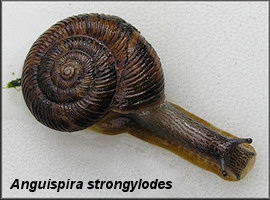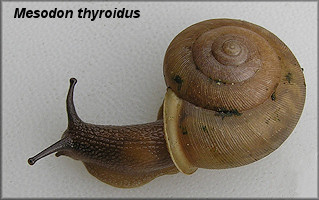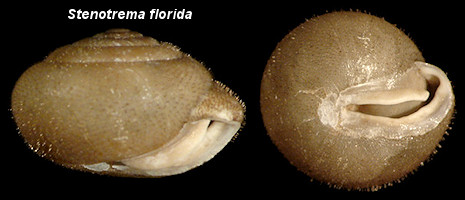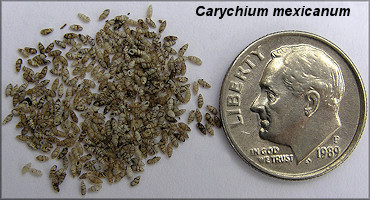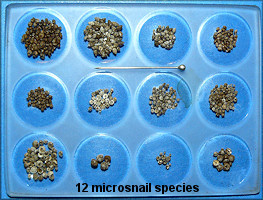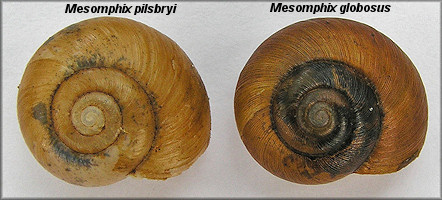|
A dirty job, but one worth doing - Florida Caverns redux |
|
|
By Harry G. Lee |
|
|
[Click on the images for a higher resolution version.] |
|
|
Near the end of last year I reviewed the land snail collections
made on the Jacksonville and Gulf Coast Shell Club joint field
trip to the vicinity of the Florida Caverns State Park,
Marianna, Jackson Co., Florida (10/13/90) plus collections
(including litter samples) made by Henry McCullagh from the same
area on 2/3/89 and 10/30/07
and posted
them on the website (see: Non-marine Mollusks Found In Levy,
Taylor & Jackson Counties Of W. Florida). My interest was piqued. Despite the
fact that Hubricht (1985) recorded a robust 50 native land snail
species from that county, no less than eight of the cumulative
30 such species we found were absent from his account. Of
perhaps more interest was the fact that nine of those 30 were
not among the 70 found in northeast Florida, where "saturation"
collecting sustained over three decades has produced as complete
an inventory as one could ask for. I think any dedicated landsnailer would sense a compulsion to do a little more systematic collecting in that provident area, which, by Jacksonville molluscan standards has every right to be called "exotic" due to the presence of those nine unfamiliar species, which have affinities with the western and northern faunas. Of particular note were three species found in the soil sample taken last October (Vertigo gouldii, Helicodiscus shimeki, and Glyphyalinia lewisiana), each of which represented a considerable extension of known range. Accordingly, I made plans for an expedition in January, but a succession of meteorological and other logistic mishaps forced several postponements. Finally at 9:00 AM on April 12 I met up with Henry in the vicinity of the caverns, a little north of Marianna, FL. Despite a light to moderate drizzle, I was able to get six samples of leaf litter, some of which obviously included the "bones" of snails. I made no special attempt to collect large snails as I felt these had been adequately sampled in past campaigns. It took many hours of processing, culling, identifying (a work in progress as the reader will see), curating and listing the 1284 specimens and includes one Patera perigrapta found by Henry. A tabulation follows. The thirty-six (36) species of land snails collected on 12 April, 2008 appear in bold [no. specimens]. Those in bold blue (9) represent additions to the 30 (actually 27 after adjustments; see below) in bold black which were previously recorded: |
|
|
[12] Helicina (Olygyra)
orbiculata (Say, 1818) Globular Drop [283] Carychium mexicanum Pilsbry, 1891 Southern Thorn [68] Gastrocopta contracta (Say, 1822) Bottleneck Snaggletooth [3] Gastrocopta corticaria (Say, 1817) Bark Snaggletooth [27] Gastrocopta pentodon (Say, 1822) Comb Snaggletooth [121] Pupisoma dioscoricola (C. B. Adams, 1845) Yam Babybody [47] Pupisoma mcneilli (Clapp, 1918) Gulf Babybody [1] Vertigo oralis Sterki, 1898 Palmetto Vertigo [3] Vertigo oscariana Sterki, 1890 Capital Vertigo [11] Strobilops aeneus Pilsbry, 1926 Bronze Pinecone [5] Strobilops texasianus Pilsbry and Ferriss, 1906 Southern Pinecone [2] Euglandina rosea (Férussac, 1821) Rosy Wolfsnail [21] Haplotrema concavum (Say, 1821) Gray-foot Lancetooth [92] Punctum minutissimum (I. Lea, 1841) Small Spot [9] Anguispira strongylodes (Pfeiffer, 1854) Southeastern Tigersnail [7] Discus patulus (Deshayes, 1832) Domed Disc [24] Euconulus trochulus (Reinhardt, 1883) Silk Hive ** [8] Glyphyalinia lewisiana (G. Clapp, 1908) Pale Glyph [98] Glyphyalinia umbilicata (Singley in Cockerell, 1893) Texas Glyph [2] Glyphyalinia solida (H. B. Baker, 1930) Imperforate Glyph [3] Hawaiia alachuana (Dall, 1885) Southeast Gem [35] Mesomphix globosus (MacMillan, 1940) Globose Button [12] Mesomphix pilsbryi (G. Clapp, 1904) Striate Button [10] Striatura meridionalis (Pilsbry and Ferriss, 1906) Southern Striate [34] Zonitoides arboreus (Say, 1817) Quick Gloss [1] Lobosculum pustuloides (Bland, 1858) Tiny Liptooth [28] Inflectarius inflectus (Say, 1821) Shagreen [1] Mesodon thyroidus (Say, 1817) White-lip Globe [1] Patera perigrapta (Pilsbry, 1894) Engraved Bladetooth [19] Stenotrema florida Pilsbry, 1940 Appalachicola Slitmouth |
|
|
|
|
|
|
|
|
Regarding the five nomina |
|
